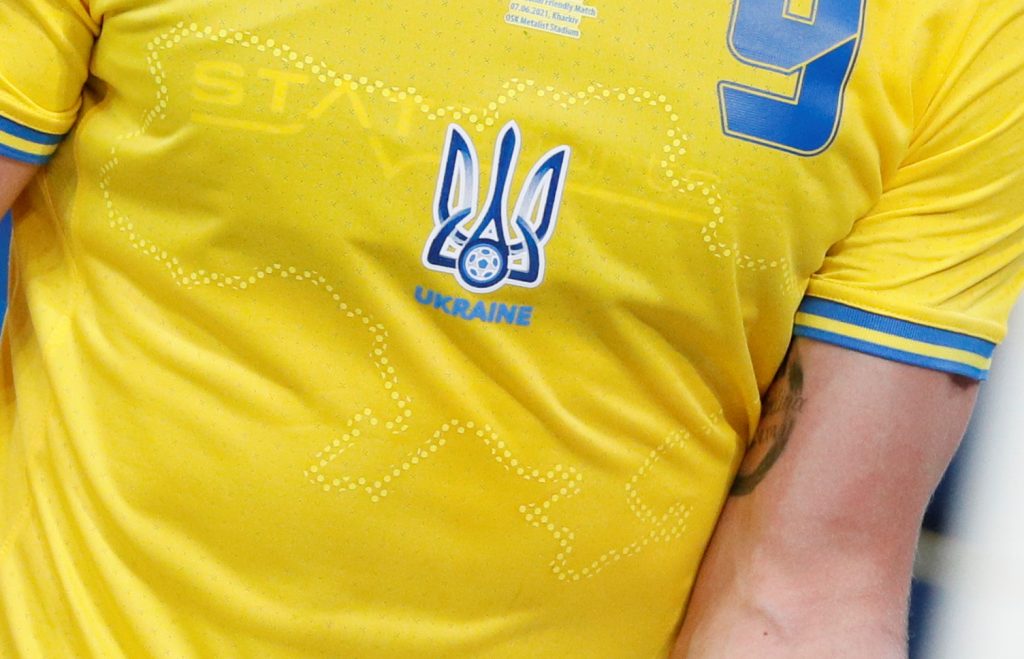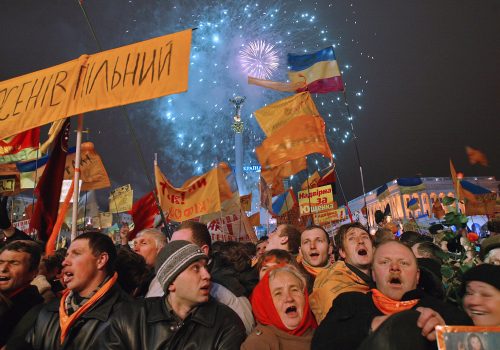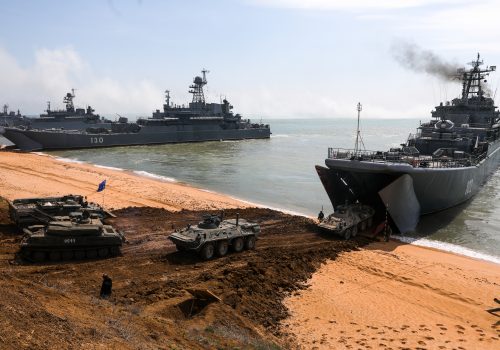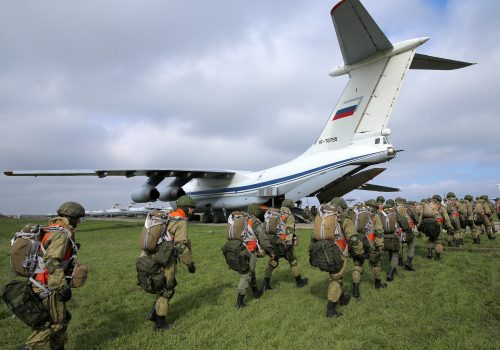Russia has expressed outrage over the new Ukrainian national football team jersey, which features a prominent outline map of Ukraine. Kremlin anger is focused on the inclusion of Crimea. The peninsula is internationally recognized as part of Ukraine but has been under Russian occupation since 2014.
The new-look football shirt was unveiled on June 6 by Ukrainian Football Association president Andriy Pavelko. “We believe the silhouette of Ukraine will give strength to the players, because they will fight for the whole of Ukraine,” commented Pavelko on Facebook. “All of Ukraine, from Sevastopol and Simferopol to Kyiv, and from Donetsk and Luhansk to Uzhhorod, will support them.” Notably, four of the six cities mentioned in Pavelko’s post (Sevastopol, Simferopol, Donetsk and Luhansk) are currently under Russian occupation.
Predictably, Ukraine’s new football shirt provoked a wave of indignation in Moscow and quickly became one of the leading news items in the Kremlin-controlled Russian mainstream media. Russian Foreign Ministry spokesperson Maria Zakharova accused Kyiv of “attaching Ukraine’s territory to Russian Crimea,” and claimed that the new jersey design “created the illusion of the impossible.” Meanwhile, Russian parliamentary deputy Dmitry Svishchev branded the shirt design “a political provocation,” and argued that it was illegal to show a map of Ukraine “which includes Russian territory.”
Russian appeals to legality are unlikely to convince international audiences, especially in the context of Crimea. The Kremlin seized control of Ukraine’s Crimean peninsula in spring 2014 using troops without identifying insignia who were later confirmed as Russian servicemen. Russian President Vladimir Putin initially denied any involvement in the takeover, but eventually admitted to personally ordering the entire operation.
While Russia continues to control Crimea, Moscow has been unable to secure international recognition for its claims to the peninsula. More than seven years after Putin triumphantly declared the “reunion” of Crimea with the Russian Federation, it remains under sanctions and is largely cut off from the outside world.
Stay updated
As the world watches the Russian invasion of Ukraine unfold, UkraineAlert delivers the best Atlantic Council expert insight and analysis on Ukraine twice a week directly to your inbox.
The geopolitical scandal over Ukraine’s new jerseys threatens to cloud preparations for the delayed Euro 2020 football championship, which kicks off later this week following last year’s pandemic-related postponement.
At this stage, Ukraine appears poised to score a symbolic victory over its giant neighbor. Despite Russian objections to the jersey design, officials from European football’s governing body, UEFA, confirmed in a June 7 statement that the Ukrainian shirt has received official approval for use in the championship.
This is not the first time the undeclared seven-year war between Russia and Ukraine has spilled over into the international arena. The two countries memorably went head-to-head at the 2016 Eurovision Song Contest, with Ukraine eventually pipping Russia to victory thanks to a haunting ballad by Ukrainian diva Jamala that told the story of the 1944 Soviet deportation of the Crimean Tatars.
Two years later during the 2018 FIFA World Cup in Russia, members of the Croatian squad made international headlines by posting a video featuring Ukrainian patriotic slogans as they celebrated knocking host nation Russia out of the competition.
Eurasia Center events

The map featuring Crimea was not the only design element of Ukraine’s new football jersey to ruffle feathers in the Kremlin. Foreign Ministry spokesperson Zakharova also objected to the inclusion of Ukraine’s official military greetings, “Glory to Ukraine!” and “Glory to the heroes!”, which she branded as copies of Nazi German slogans, while also emphasizing their connections to WWII-era Ukrainian nationalist organizations.
Claims of this nature are nothing new and have traditionally played a key role in Kremlin efforts to discredit Ukraine’s national liberation movement by associating it with Nazi collaboration. In reality, the modern struggle for an independent Ukraine predates the totalitarian era by more than a hundred years and has its roots in the first half of nineteenth century.
The origins of the “Glory to Ukraine!” refrain can also be traced back to this period. It had already emerged as a popular slogan among Ukrainian patriots at the time of Ukraine’s failed early twentieth century statehood bid, decades before the outbreak of WWII.
In more recent years, “Glory to Ukraine!” served as a favored rallying cry during Ukraine’s 2013-14 Euromaidan Revolution. It gained unprecedented popularity among protesters as millions took to the streets of Kyiv and other Ukrainian cities to prevent the country from sliding towards Kremlin-style authoritarianism.
In 2018, the slogan gained official status when it was adopted as the standard greeting of the Ukrainian Armed Forces. It is now routinely used by Ukrainian officials including President Volodymyr Zelenskyy, along with visiting dignitaries and heads of state such as Turkish President Recep Tayyip Erdogan.
None of this has persuaded Russia to abandon its disinformation campaign over the origins and contemporary context of the “Glory to Ukraine!” slogan. Indeed, Moscow has actually doubled down in recent years, stubbornly clinging to its portrayal of Ukraine as a hotbed of Nazism despite the wholesale rejection of nationalist political parties in every single Ukrainian presidential and parliamentary election since 2014. Even the landslide victory of Russian-speaking Jewish presidential candidate Volodymyr Zelenskyy in 2019 failed to shake Moscow’s resolve.
This is perhaps less surprising than it might initially appear. As a revisionist power seeking to reverse the verdict of 1991, the Putin regime has had good reason to revive Soviet era propaganda narratives of “fascist Ukraine” as a means of justifying renewed Russian aggression and demonizing Ukrainian national identity. Dating back to the early years of the Cold War, this warped view of Ukraine continues to resonate in the post-Soviet world, where the USSR’s staggering WWII losses mean the fight against Hitler remains a uniquely emotive issue.
From a Ukrainian perspective, debunking such distortions is a national security priority. Over the past seven years, Ukraine’s low profile and relative obscurity have left the country highly vulnerable to the disinformation strategies that lie at the heart of Putin’s hybrid war doctrine. However, the tide may gradually be turning. The weaponization of the national football team’s Euro 2020 jerseys is an indication that Ukraine is learning to fight back, and is capable of doing so in an increasingly confident and creative manner.
Peter Dickinson is Editor of the Atlantic Council’s UkraineAlert Service.
Further reading
The views expressed in UkraineAlert are solely those of the authors and do not necessarily reflect the views of the Atlantic Council, its staff, or its supporters.

The Eurasia Center’s mission is to enhance transatlantic cooperation in promoting stability, democratic values and prosperity in Eurasia, from Eastern Europe and Turkey in the West to the Caucasus, Russia and Central Asia in the East.
Follow us on social media
and support our work
Image: The new Ukrainian national team jersey featuring a map of Ukraine including Crimea pictured during an international friendly match against Cyprus in Kharkiv on June 7, 2021. (REUTERS/Gleb Garanich)




